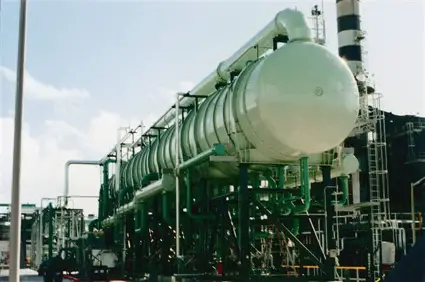Desalination Plants Worldwide
Of the more than 12,500 desalination plants in operation worldwide, 60% are located in the Middle East. Total world capacity is approaching 30 million m3/day of potable water (almost 8 billion gallons per day).
The world’s largest plant in Saudi Arabia produces 128 Million Gallons a Day (MGD) of desalted water. In contrast, 12% of the world’s capacity is produced in the Americas, with most of the plants located in the Caribbean and Florida. To date, a limited number of plants have been built, primarily because the cost is generally higher than the costs of other water supply alternatives available (e.g., water transfers and groundwater pumping). However, as drought conditions occur and concern over water availability increases, desalination projects are being proposed at numerous locations around the world.

IDE Technologies Ltd. has recently signed a contract for the provision of two ‘desal’ units for a power plant in Kazakhstan.
Desalination Technologies
Desalination is a process that removes dissolved minerals (including but not limited to salt) from seawater, brackish water, or treated waste water. A number of technologies have been developed, including reverse osmosis (RO), distillation, electrodialysis, and vacuum freezing. These methods are described below.
• Reverse Osmosis (RO) In RO, feedwater is pumped at high pressure through permeable membranes, separating salts from the water. The feedwater is pre-treated to remove particles that would clog the membranes. The quality of the water produced depends on the pressure, the concentration of salts in the feedwater, and the salt permeation constant of the membranes. Product water quality can be improved by adding a second pass of membranes, whereby product water from the first pass is fed to the second pass.
• Distillation In the distillation process, feedwater is heated and then evaporated to separate out dissolved minerals. The most common methods of distillation include multistage flash (MSF), multiple effect distillation (MED), and vapour compression (VC).
In MSF, the feedwater is heated and the pressure is lowered, so the water “flashes” into steam. This process constitutes one stage of a number of stages in series, each of which is at a lower pressure. In MED, the feedwater passes through a number of evaporators in series. Vapour from one series is subsequently used to evaporate water in the next series. The VC process involves evaporating the feedwater, compressing the vapour, then using the heated compressed vapour as a heat source to evaporate additional feedwater. Some distillation plants are a hybrid of more than one desalination technologies. The waste product from these processes is a solution with high salt concentration.
Costs
Desalination typically requires large amounts of energy as well as specialised expensive infrastructure, making it very costly compared to the use of fresh water from rivers or wells (bores). Most plants today use fossil fuels as a power source, and thus they contribute to increased levels of greenhouse gases. The major technology in use is the multi-stage flash (MSF) distillation process using steam, but reverse osmosis (RO) driven by electric pumps is increasingly significant.
With brackish water, RO is much more cost-effective, though MSF gives purer water than RO. A minority of plants use multi-effect distillation (MED) or vapour compression (VC). MSF-RO hybrid plants exploit the best features of each technology for different quality products.
Desalination is energy-intensive. Reverse Osmosis needs about 6 kWh of electricity per cubic metre of water (depending on its salt content), while MSF and MED require heat at 70-130°C and use 25-200 kWh/m3. A variety of low-temperature heat sources may be used, including solar energy. The choice of process generally depends on the relative economic values of fresh water and particular fuels.
Some 10% of Israel’s water is desalinated, and one large RO plant provides water at 50 cents per cubic metre. Malta gets two thirds of its potable water from RO. Singapore in 2005 commissioned a large RO plant supplying 136,000 m3/day (36MGD) or 10% of needs, at 49 cents US per cubic metre.
Environment
Regardless of the method used, there is always a highly concentrated waste product consisting of everything that was removed from the created fresh water. This is sometimes referred to as brine, which is also a common term for the byproduct of recycled water schemes that is often disposed of in the ocean. These concentrates are classified by the United States Environmental Protection Agency as industrial wastes.
With coastal facilities, it may be possible to return it to the sea without harm if this concentrate does not exceed the normal ocean salinity gradients to which osmoregulators are accustomed. Reverse osmosis, for instance, may require the disposal of wastewater with a salinity twice that of normal seawater. The marine community cannot accommodate such an extreme change in salinity and many filter-feeding animals would be destroyed when the water is returned to the ocean. This presents an increasing problem further inland, where one needs to avoid ruining existing fresh water supplies such as ponds, rivers and aquifers. As such, proper disposal of concentrate needs to be investigated during the design phases.
